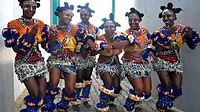
Photo from wikipedia
In insects, odours are coded by the combinatorial activation of ascending pathways, including their third-order representation in mushroom body Kenyon cells. Kenyon cells also receive intersecting input from ascending and… Click to show full abstract
In insects, odours are coded by the combinatorial activation of ascending pathways, including their third-order representation in mushroom body Kenyon cells. Kenyon cells also receive intersecting input from ascending and mostly dopaminergic reinforcement pathways. Indeed, in Drosophila, presenting an odour together with activation of the dopaminergic mushroom body input neuron PPL1-01 leads to a weakening of the synapse between Kenyon cells and the approach-promoting mushroom body output neuron MBON-11. As a result of such weakened approach tendencies, flies avoid the shock-predicting odour in a subsequent choice test. Thus, increased activity in PPL1-01 stands for punishment, whereas reduced activity in MBON-11 stands for predicted punishment. Given that punishment-predictors can themselves serve as punishments of second order, we tested whether presenting an odour together with the optogenetic silencing of MBON-11 would lead to learned odour avoidance, and found this to be the case. In turn, the optogenetic activation of MBON-11 together with odour presentation led to learned odour approach. Thus, manipulating activity in MBON-11 can be an analogue of predicted, second-order reinforcement.
Journal Title: Biology Letters
Year Published: 2019
Link to full text (if available)
Share on Social Media: Sign Up to like & get
recommendations!